10 UNESCO World Heritage Sites to Visit in France During the Olympics
Visitors to the Olympics will not only be able to enjoy the sports while supporting their favorite countries and athletes. France offers an unusual...
Ledys Chemin 29 July 2024
Many edifices, shrines, dagobas, and colossal figures attest to the glory of Polonnaruwa, the second (and strikingly beautiful) capital of ancient Sri Lanka. Located in North Central Province, Polonnaruwa is depicted in chronicles as a fabulous garden city where King Parakramabahu I grew a thousand plants of all varieties in the 12th century. The city and its monumental set of ruins, perfectly integrated with the vegetation, were declared a World Heritage Site by UNESCO in 1982.
Polonnaruwa once stood out as the social, political, and religious center of Sri Lanka. Wandering (or biking) through its 122 hectares of land is an exciting journey back in time. The city became the capital of ancient Sri Lanka after the fall of Anuradhapura in 993, whose dominion on the island lasted around 1400 years. At that time, the South Indian Chola dynasty had conquered most of the country. Polonnaruwa was occupied in 1017 due to its strategic location and was used as the seat of the Chola government. This explains why so many Hindu monuments and sculptures were found in the city. However, in 1070 King Vijayabahu I (1055-1110) defeated the Cholas, re-establishing Sinhalese kingship and Buddhist practices in Polonnaruwa.
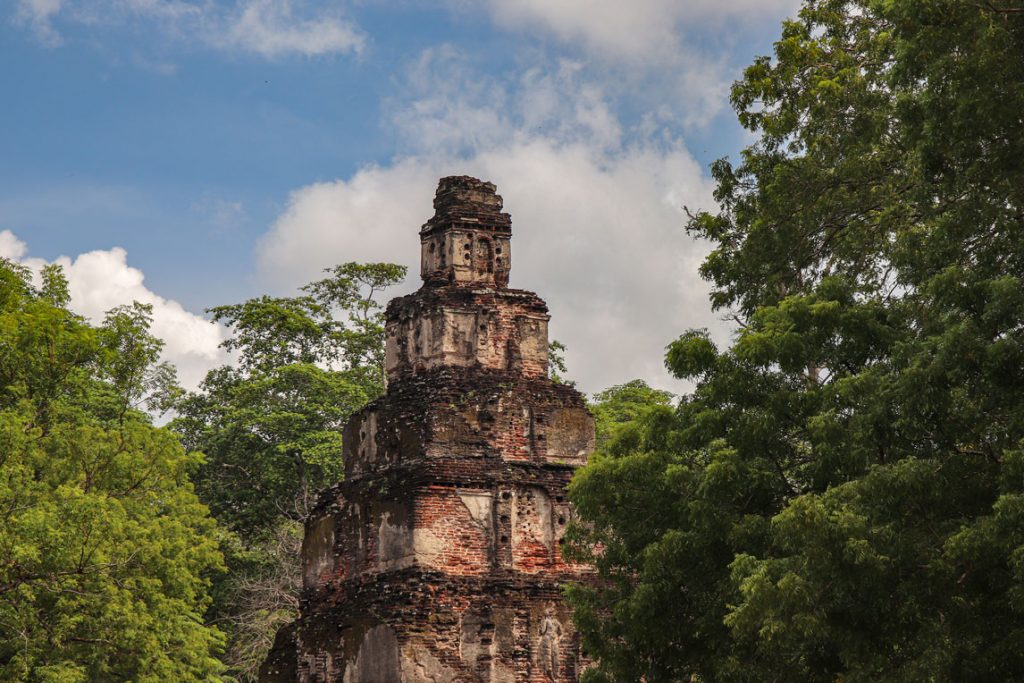
Satmahal Prasada, Polonnaruwa, Sri Lanka. Photo by the author.
A new golden era came with Parakramabahu the Great (1153-1186), one of the most eminent kings in Sri Lankan history. Among his many achievements is the beautification of Polonnaruwa, the buildings and shrines he constructed are an exquisite reflection of his reign. His palace was described in the chronicles as a dreamlike place, including seven stories and a thousand rooms. King Nissanka Malla (1187-1196) followed in Parakramabahu’s footsteps, but his reign would be the last period of peace and political stability in Polonnaruwa.
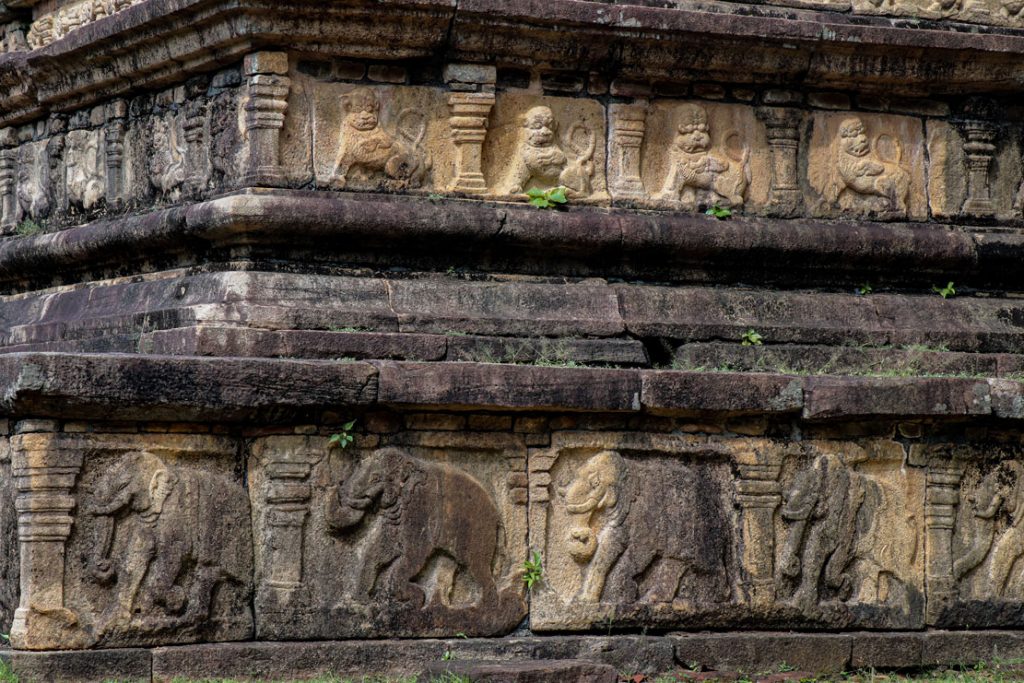
Animal motif reliefs at the Council Chamber of Parakramabahu I, Polonnaruwa, Sri Lanka. Photo by the author.
One of Polonnaruwa’s main attractions is the beauty of its carvings, reflecting the expertise of Sinhalese sculptors. The decorative motifs are mainly concentrated at the entrances of buildings, as ancient Buddhist architecture limited its ornamentation to stairways, plinths, and wall surfaces.
Pilgrims are greeted by stately and richly attired stone guardians who support the balustrades, often used to depict deities or lion figures. The doorframes are also profusely decorated, following the Indian tradition. The pillars feature varied and unique carvings and can even take the shape of delicate lotus flower stems.
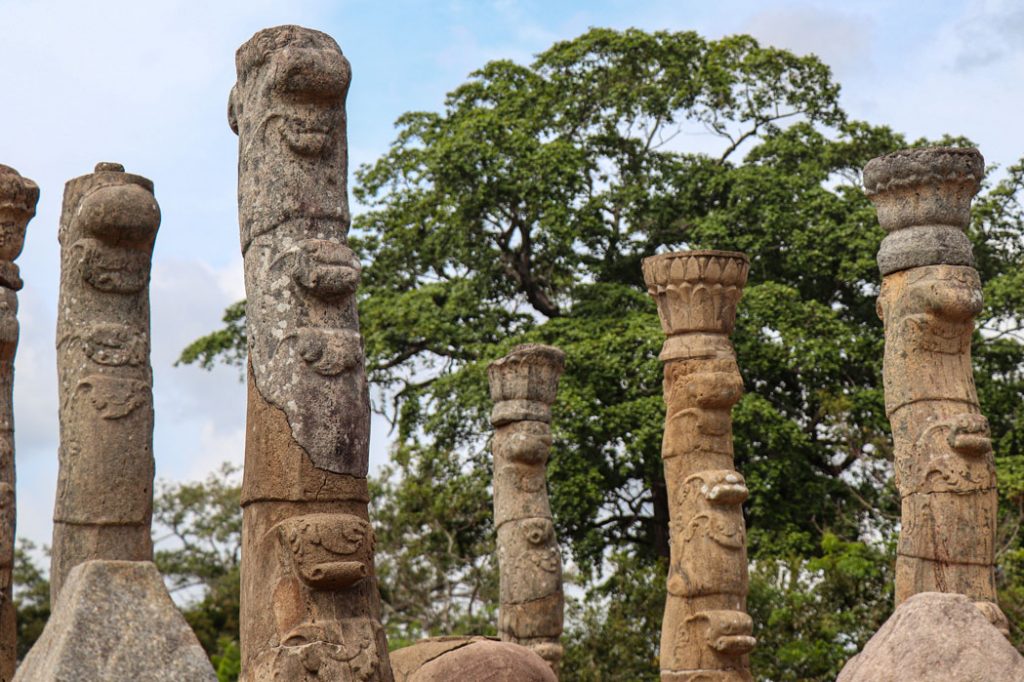
Lotus flower stem-shaped pillars at Nissanka Latha Mandapa, Polonnaruwa, Sri Lanka. Photo by the author.
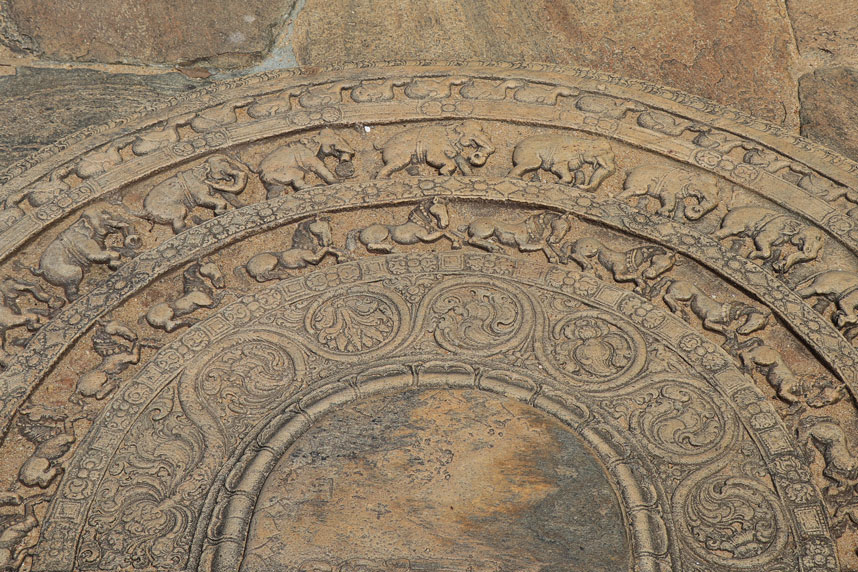
Detail of a moonstone, Polonnaruwa, Sri Lanka. Photo by the author.
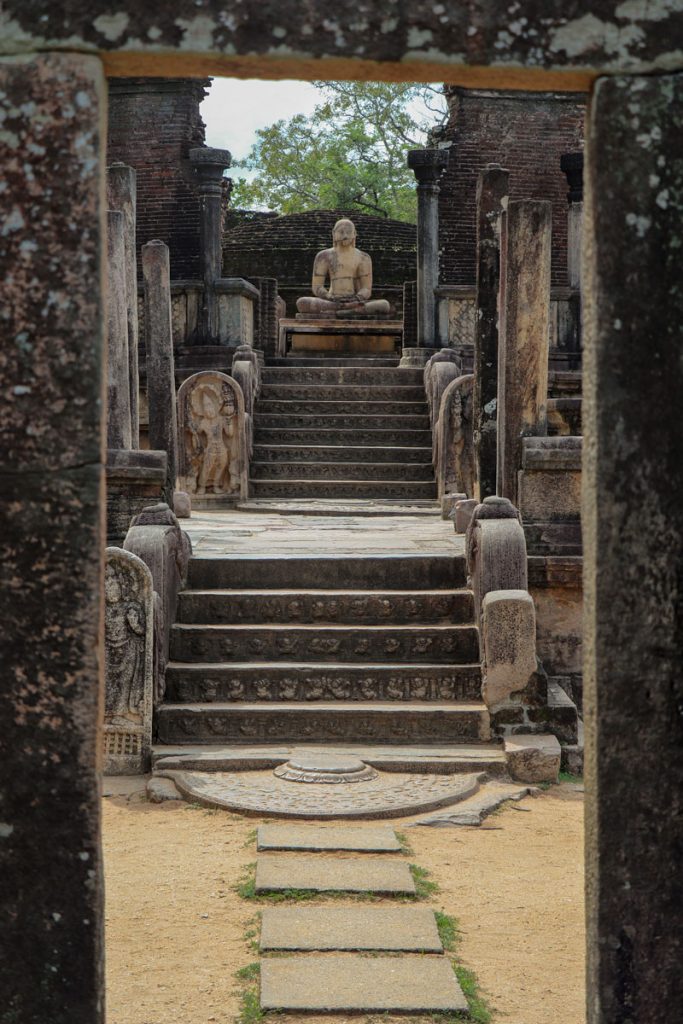
Northern entrance of Vatadage, Polonnaruwa, Sri Lanka. Photo by the author.
Some of Polonnaruwa’s most sacred monuments can be found in the Quadrangle, where the Buddha’s tooth was once worshipped. According to legend, the Buddha’s body was cremated after his death, but some parts remained unburned and became relics. Of these relics, the most famous is the Sacred Tooth Relic. It was venerated in every Sri Lankan kingdom. Furthermore it became the main symbol of royalty as its possession was necessary to legitimize royal authority. Today, the Sacred Tooth Relic is kept in the city of Kandy.
The Sacred Quadrangle has the highest concentration of buildings in Polonnaruwa as well as the most beautiful architectural structures. The central unit is the Vatadage, or Circular Relic House, built to worship the Sacred Tooth Relic. This building stands on a terrace accessed by four entrances facing the cardinal points. Each entry has a statue of a seated Buddha, protecting a small dagoba behind them. The Sacred Tooth Relic was also kept in other buildings in the Quadrangle, as each king built his own Temple of the Tooth.
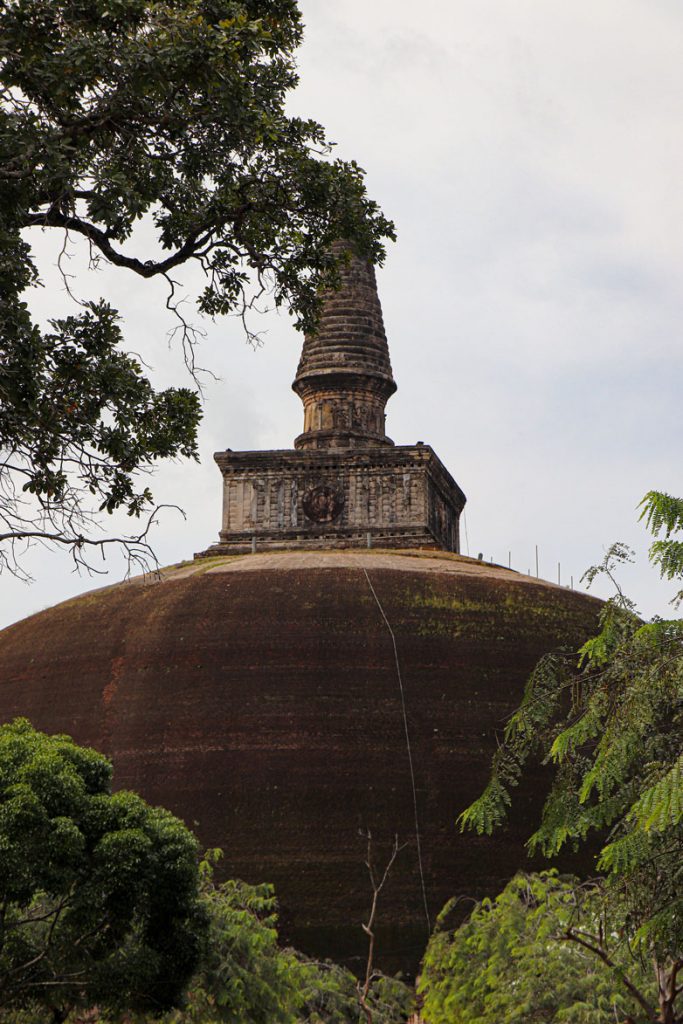
Rankoth Vehera, Polonnaruwa, Sri Lanka. Photo by the author.
Stupas (also known as dagobas or veheras in Sri Lanka) are Buddhist architectural monuments that house relics of the historical Buddha and his associates, although they are inaccessible. These monuments can also commemorate a sacred place. Magnificent dagobas were built during the Polonnaruwa period, the largest of which is Rankoth Vehera, standing 180 feet high and 550 feet in circumference.
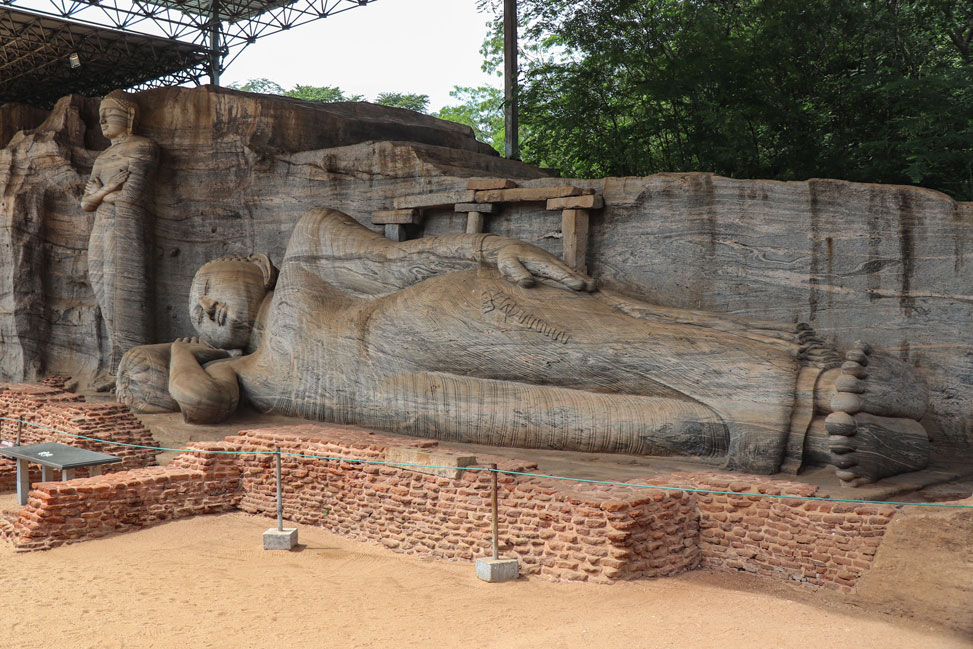
Colossal Buddha statues in Gal Vihara, Polonnaruwa, Sri Lanka. Photo by the author.
Gal Vihara is the most emblematic monument of Polonnaruwa. It features colossal Buddha statues carved into the face of the living rock. The delicate modeling of the bodies, the rhythmic treatment of the drapery, and the meticulous attention to every detail make this ensemble an example of the extraordinary artistic richness of the sculptors of Polonnaruwa. The statues represent the Buddha in three positions: seated, standing, and reclining.
To learn more about Sri Lankan art, a visit to the Cultural Triangle is a must. Six extraordinary sites of historical-artistic interest form a triangle in the center of the island, the angles of which correspond to Polonnaruwa, Anuradhapura, and Kandy, the three ancient kingdoms of the country.
In this triangular area are Sigiriya, the Lion Rock, one of the best-preserved archaeological sites in Asia and famous for its 5th-century frescoes, and Dambulla, an impressive complex of cave temples filled with paintings and sculptures dating from the 18th and 19th centuries. The Cultural Triangle also includes the Jetavana monastery and its gigantic stupa, founded in the 3rd century.
DailyArt Magazine needs your support. Every contribution, however big or small, is very valuable for our future. Thanks to it, we will be able to sustain and grow the Magazine. Thank you for your help!